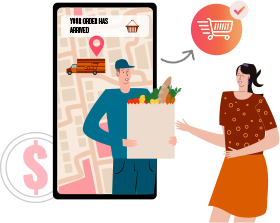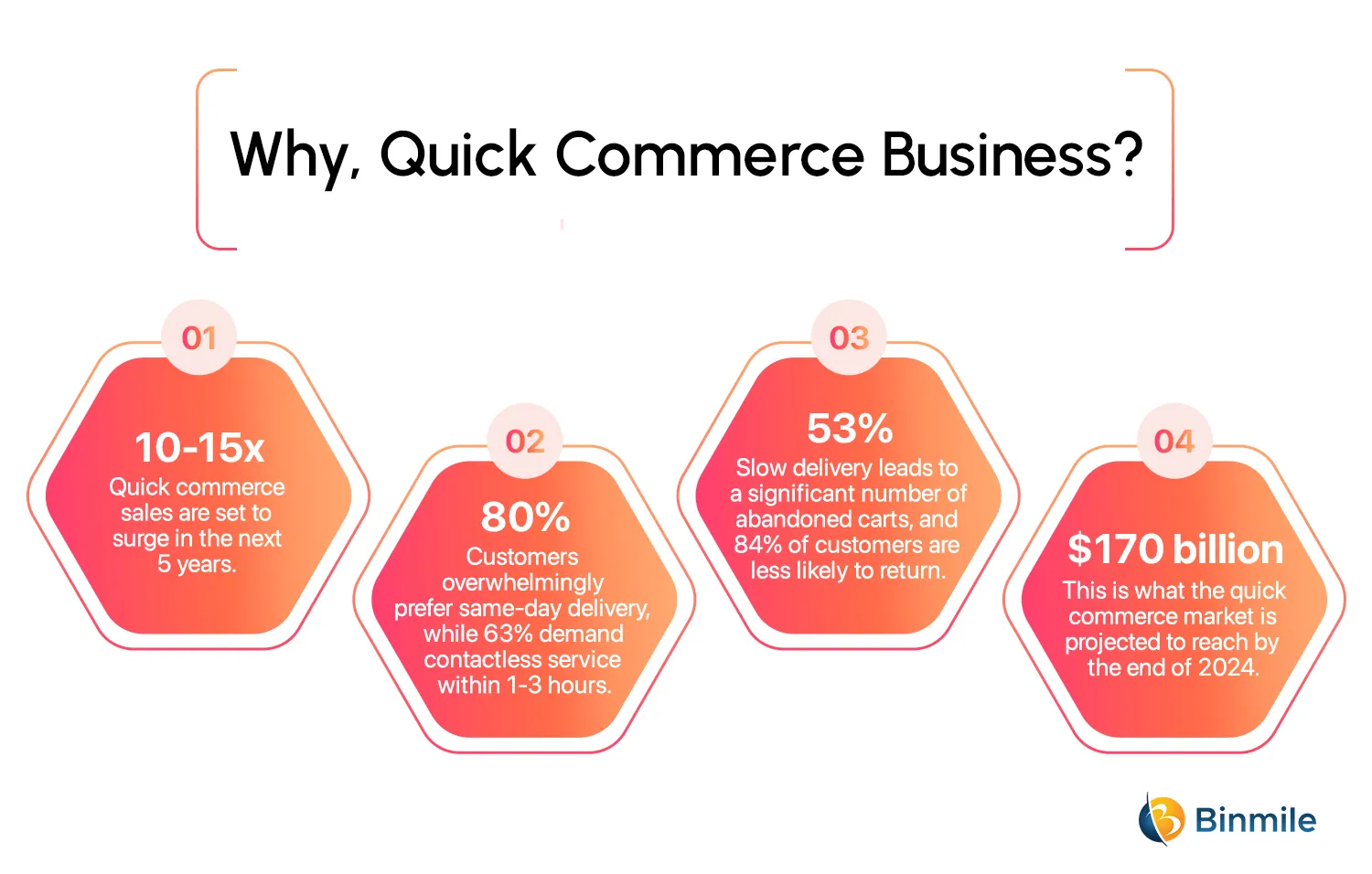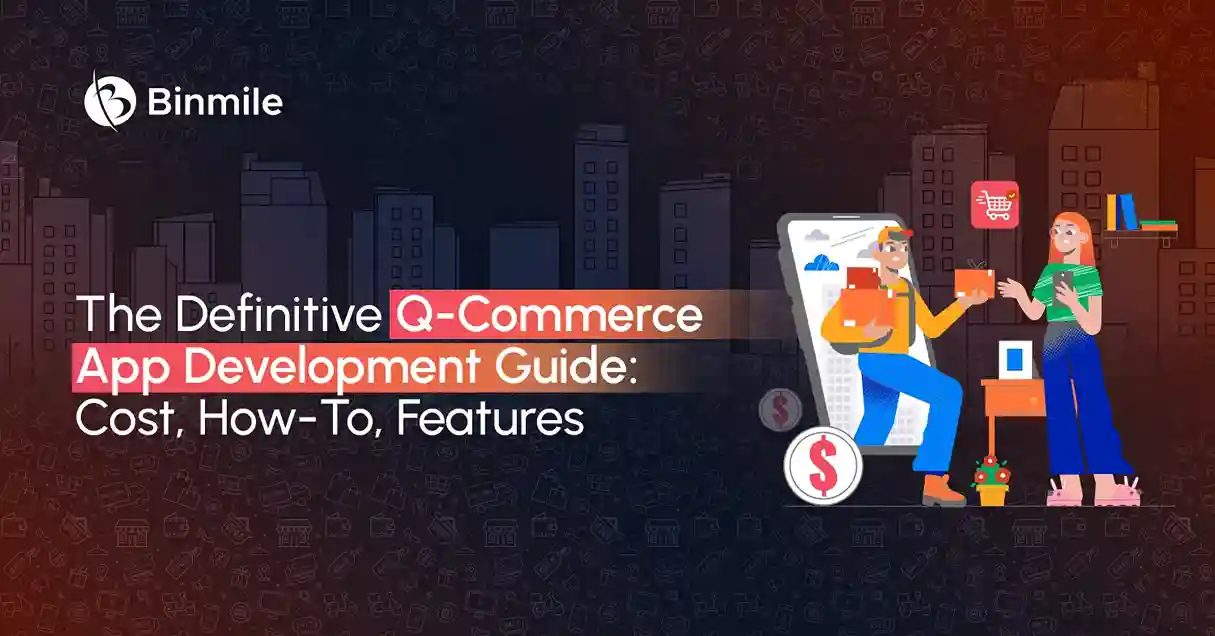Digitalization has transformed the way customers expect products or services on demand. Q-commerce, or quick commerce, is another new trend that has reshaped how we shop for groceries or order food by offering lightning-fast delivery services. Whether it’s groceries delivery app or an online food ordering app, Q-commerce app development bridges the gap between traditional e-commerce and instant gratification, offering a wide range of products delivered swiftly to the customer’s location.
So in case you are thinking of developing a Quick Commerce app, you have just got one with the smartest idea to experience unlimited success in your life. However, developing a successful Q-commerce platform requires careful planning and execution. From understanding your target audience and building a robust infrastructure to optimizing delivery operations and providing exceptional customer service, there are several key steps involved. In this comprehensive guide, we will delve into the seven essential steps to successfully develop a Q-commerce platform. By following these guidelines, you can position your business for growth and success in the fast-paced world of q-commerce.
Comprehensive Guide to Q-Commerce App Development: Key Strategies for Success
Termed as the golden child of e-commerce, Q-commerce is a unique business model that offers little to no order placement and delivery window. In simple terms, it’s an on-time delivery model that has decreased the 1-day delivery window to a 10-30 minute time frame. This delivery model, a hallmark of the quick commerce business model, involves a quick order fulfillment process that caters to micro-to-smaller quantities of food, varied from groceries, stationeries, pharmacies, and many more.

1. Define Core Features & Functionality
Determine essential features like product listings, search functionality, shopping cart, and checkout process. Plan additional capabilities such as real-time order tracking and estimated delivery times. Prioritize features for your minimum viable product versus future iterations.
- Prioritize essential features: Determine the most crucial features, such as product listings, search, cart, and checkout.
- Plan for future enhancements: Consider additional features like real-time tracking, estimated delivery times, and personalized recommendations.
- Balance feature set: Avoid feature bloat and focus on only those features or functionalities that address your target audience’s needs and preferences.
2. Choose the Right Technology Stack
Selecting the appropriate technology stack is crucial for Q-commerce development, but more so for ensuring that you can offer a seamless user experience, scalability, and integration with other essential business processes. Consider the following factors:
- Programming language: Popular choices include Python, JavaScript, and Ruby.
- Framework: Frameworks like Django, Node.js, and Ruby on Rails can streamline development.
- Database: A robust database like PostgreSQL or MongoDB is essential for handling large datasets.
- Cloud platform: Consider cloud platforms like AWS, GCP, or Azure for scalability and flexibility.
3. Build a Robust Infrastructure
A solid infrastructure is essential for a successful Q-commerce platform and the success of any online business. It forms the foundation that supports all of the processes, functionalities, and transactions involved in running an online store. This includes:
- Inventory management system: Efficiently track and manage your inventory to avoid stockouts and overstocking.
- Order management system: Streamline the order fulfillment process and ensure accurate and timely delivery.
- Delivery network: Establish a reliable and efficient delivery network to meet your customers’ expectations.
- Technology platform: Choose a technology platform that can handle high order volumes and provide a seamless customer experience.
4. Design the User Experience & Interface
Have engaging, intuitive, and mobile-friendly designs and user interfaces to ensure a seamless experience from product discovery to order completion.
- Create user flows: Map out the customer journey from product discovery to purchase completion.
- Design intuitive UI: Develop a visually appealing and user-friendly interface that is easy to navigate.
- Optimize for mobile: Ensure your platform is fully optimized for mobile devices, as a significant portion of Q-commerce traffic comes from smartphones.
- Prioritize usability: Conduct usability testing to identify and address any pain points in the user experience.
5. Optimize Your Delivery Operations
An efficient and reliable delivery process helps in streamlining the process of getting products to customers on time and in good condition, leading to a better customer experience. To optimize your delivery operations, focus on:
- Choosing the right delivery method: Consider factors such as distance, traffic, and order volume when selecting delivery methods (e.g., in-house delivery, third-party courier).
- Optimizing delivery routes: Use route optimization software to minimize delivery time and costs.
- Investing in delivery technology: Implement technologies such as GPS tracking and real-time order updates to improve visibility and transparency.
6. Set Up Logistics and Operations
- Establish partnerships: Partner with local stores or warehouses to source products efficiently.
- Implement order management: Use order management systems to streamline the fulfillment process.
- Coordinate deliveries: Develop efficient delivery routes and assign orders to delivery personnel.
- Train delivery personnel: Provide thorough training to ensure quality service and customer satisfaction.
7. Continuous Testing, and Iteration
Once you’re done with the development QA testing and the following updates and changes are crucial to assess, verify, validate, and test q-commerce websites and apps. This is done to help you evaluate whether the platform and app conform to all standards and regulations required for secure transactions and are also performing as intended. Additionally, you can release a beta version to gather user feedback and identify areas for improvement; doing so continuously refines and enhances your platform based on analytics and user input.
- Conduct thorough testing: Perform functional, performance, and security tests to identify and address any issues.
- Gather user feedback: Release a beta version to gather user input and insights.
- Analyze data: Use analytics tools to track user behavior and identify areas for improvement.
- Continuously iterate: Make ongoing updates and enhancements based on user feedback and data analysis.
*Bonus Point
8. Develop the Minimum Viable Product (MVP)
MVP development for your q-commerce lets you do some real-world testing to prove whether new q-commerce strategies will work for your business or not and gather user feedback. Later, you assess the insights into q-commerce development and improve, customize, and launch the product or project in time, under a reasonable price.
Our result-driven mobile app solutions are the express lane to Q-commerce success! Let's discuss your goals and create a tailored strategy.

How to Reduce Q-commerce App Development Costs?
To answer how much it costs to build a quick commerce app, an estimated app development cost for a q-commerce app can be anywhere between $40,000 to $450,000, or more depending on factors like features, UI/UX, or app type. However, there are a few ways you can lower this cost, let’s discuss them:

- Prioritize Essential Features: Focus on essential features that are required to build MVP; add advanced features as the user base grows. This helps you control costs, optimize resources, and launch your app faster.
- Leverage Open-Source Technologies: They offer an extensive range of frameworks, libraries, tools, and resources for app development services. Also, eliminates the need for any substantial financial investment for building functionalities from scratch.
- Consider Outsourcing or Remote Teams: Outsourcing mobile app development services can greatly lower your app development cost, especially if you choose an offshore provider with lower labor costs.
- Optimize Development Process: Use app development tools and frameworks to simplify the development process. Additionally, test your app early and often; this lets you catch bugs and issues early on, leading to time and cost- savings in the longer run.
Know the Difference: Quick-Commerce vs e-Commerce
Quick Commerce for Business: Numbers & Facts

Q-Commerce Mobile App Essential Features:
- User Registration and Login
- Product Catalog
- Search and Filtering
- Shopping Cart
- Checkout Process
- Order Tracking
- Notifications
- Real-time Inventory
- Hyperlocal Delivery
- Delivery Slots
- Pickup Options
- Subscription Services
- Personalized Recommendations
- Push Notifications
- Social Login
- Reviews and Ratings
- Loyalty Programs
- Offline Mode
- Integration with Other Channels
Overwhelmed by the complexity of Q-commerce app development? Our team can handle the entire process, from design to deployment.

Wrapping It Up
Undoubtedly, Q-commerce app development offers a vast opportunity for businesses to connect with customers in a meaningful and efficient way.However, to explore and tap into this growing market with apps like Q-commerce grocery delivery solutions such as Instacart, businesses need to build feature-rich and user-friendly custom mobile app solutions. It’s easier said than done. There are millions of custom mobile solutions available online, therefore, it’s difficult to make your digital product stand out. Difficult but not impossible. With an effective and thorough Q-commerce app development guide and strategy, you can easily develop a mobile app that delivers a smooth buying experience, unparalleled convenience, and speed to your customers.
Therefore, success in any mobile app development service landscape requires a combination of strategic planning, technological innovation, and a customer-centric approach. Hopefully, this comprehensive app development guide has given you in-depth insight into how to make a custom app for last-mile delivery services, subsequently empowering you to thrive in the competitive landscape of Q-commerce.
Frequently Asked Questions
Q-Commerce, short for Quick Commerce, refers to a subset of e-commerce focused on delivering goods to customers in a much shorter timeframe, often within minutes or hours. It emphasizes speed, convenience, and efficiency to cater to the on-demand needs of modern consumers.
Unlike traditional e-commerce, which may take days to deliver products, quick commerce ensures ultra-fast delivery, typically for small, high-demand items like groceries, pharmaceuticals, or personal care products.
Yes, Q-Commerce can be an excellent choice for small businesses targeting a local customer base. It provides a competitive edge by offering faster delivery and improving customer satisfaction.
Consider software that offers scalability, advanced analytics, easy integration with third-party tools, and robust customer support. It should also align with your specific business needs and growth objectives.









